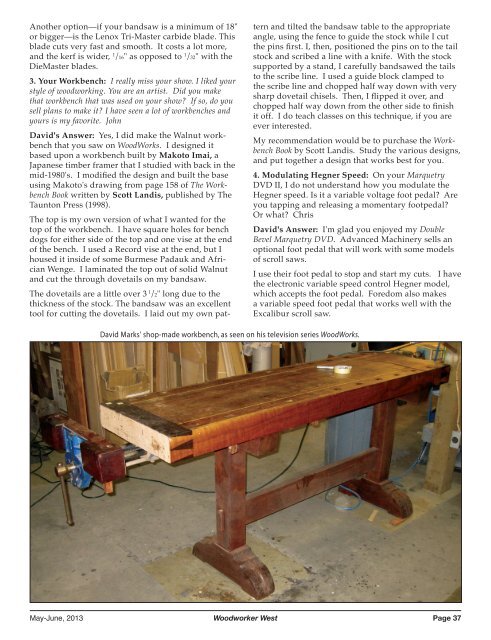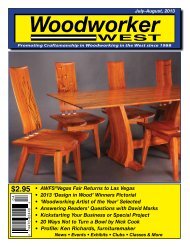Woodworker West (May-June, 2013)
Covering woodworking in the Western U.S. For the hobbyist to professional woodworker, furniture maker, woodturner, and anyone else working with wood.
Covering woodworking in the Western U.S. For the hobbyist to professional woodworker, furniture maker, woodturner, and anyone else working with wood.
Create successful ePaper yourself
Turn your PDF publications into a flip-book with our unique Google optimized e-Paper software.
Another option—if your bandsaw is a minimum of 18"<br />
or bigger—is the Lenox Tri-Master carbide blade. This<br />
blade cuts very fast and smooth. It costs a lot more,<br />
and the kerf is wider, 1 /16" as opposed to 1 /32" with the<br />
DieMaster blades.<br />
3. Your Workbench: I really miss your show. I liked your<br />
style of woodworking. You are an artist. Did you make<br />
that workbench that was used on your show? If so, do you<br />
sell plans to make it? I have seen a lot of workbenches and<br />
yours is my favorite. John<br />
David's Answer: Yes, I did make the Walnut workbench<br />
that you saw on WoodWorks. I designed it<br />
based upon a workbench built by Makoto Imai, a<br />
Japanese timber framer that I studied with back in the<br />
mid-1980's. I modified the design and built the base<br />
using Makoto's drawing from page 158 of The Workbench<br />
Book written by Scott Landis, published by The<br />
Taunton Press (1998).<br />
The top is my own version of what I wanted for the<br />
top of the workbench. I have square holes for bench<br />
dogs for either side of the top and one vise at the end<br />
of the bench. I used a Record vise at the end, but I<br />
housed it inside of some Burmese Padauk and Africian<br />
Wenge. I laminated the top out of solid Walnut<br />
and cut the through dovetails on my bandsaw.<br />
The dovetails are a little over 3 1 /2" long due to the<br />
thickness of the stock. The bandsaw was an excellent<br />
tool for cutting the dovetails. I laid out my own pat-<br />
tern and tilted the bandsaw table to the appropriate<br />
angle, using the fence to guide the stock while I cut<br />
the pins first. I, then, positioned the pins on to the tail<br />
stock and scribed a line with a knife. With the stock<br />
supported by a stand, I carefully bandsawed the tails<br />
to the scribe line. I used a guide block clamped to<br />
the scribe line and chopped half way down with very<br />
sharp dovetail chisels. Then, I flipped it over, and<br />
chopped half way down from the other side to finish<br />
it off. I do teach classes on this technique, if you are<br />
ever interested.<br />
My recommendation would be to purchase the Workbench<br />
Book by Scott Landis. Study the various designs,<br />
and put together a design that works best for you.<br />
4. Modulating Hegner Speed: On your Marquetry<br />
DVD II, I do not understand how you modulate the<br />
Hegner speed. Is it a variable voltage foot pedal? Are<br />
you tapping and releasing a momentary footpedal?<br />
Or what? Chris<br />
David's Answer: I'm glad you enjoyed my Double<br />
Bevel Marquetry DVD. Advanced Machinery sells an<br />
optional foot pedal that will work with some models<br />
of scroll saws.<br />
I use their foot pedal to stop and start my cuts. I have<br />
the electronic variable speed control Hegner model,<br />
which accepts the foot pedal. Foredom also makes<br />
a variable speed foot pedal that works well with the<br />
Excalibur scroll saw.<br />
David Marks' shop-made workbench, as seen on his television series WoodWorks.<br />
<strong>May</strong>-<strong>June</strong>, <strong>2013</strong> <strong>Woodworker</strong> <strong>West</strong> Page 37



